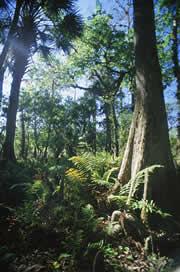 How old? Most tropical trees don't have rings.Getty
How old? Most tropical trees don't have rings.GettyAs every child knows, you can tell how old a tree is simply by counting its rings, which reflect the changing seasons. Now researchers have worked out a simple way to do the same for trees from the tropics, where there are no summers and winters to mark the passage of time.
If the method proves accurate, climate researchers and rainforest ecologists alike could benefit from the approach.
Characteristics such as the width of tree rings in temperate zones are currently used to provide a detailed record of climate conditions for the past 1,000 years or so.
But in the tropics, only a very few types of tree, such as teak, have visible rings: for most trees the difference between wet and dry seasons is too subtle to make a distinct mark. Instead, researchers have had to rely on time-consuming measurements of oxygen and carbon isotopes to age parts of these trees.
Other options for climate records in the tropics include corals and lake sediments. But the record in corals goes back only a few hundred years, and sediments don't provide a year-by-year picture. Large tropical trees, in contrast, hold the potential to give annual records for the past millennium.
Invisible data
Fortunately, Pascale Poussart, a geochemist at Princeton University in New Jersey, and her colleagues, have shown that an apparently ringless Miliusa velutina tree from Thailand does have rings... they're just invisible.
The team used X-ray beams at the Brookhaven National Synchrotron Light Source to look at calcium, a mineral that trees take up during their main growing season, in wood samples. The result: annual peaks going back to 1909, they report in Geophysical Research Letters1.
The results matched up nicely with carbon isotope measurements, the researchers say. But the calcium method is much quicker. "It took us just one afternoon in the synchrotron to produce the record," says Poussart. "The isotope record cost four months of lab time."
"Identifying the incidence of dry seasons from calcium content is a most welcome development," says Paul Colinvaux, a senior research scientist at the Marine Biological Laboratory in Woods Hole, Massachusetts, and an expert in tropical climate records. "Calcium content clearly offers the chance of obtaining records from many more species than the miserable few with visible rings," he says.
Where next?
The team doesn't yet know whether seasonal calcium cycles are common, or if the feature is specific to just a few types of trees. And it is unclear whether periods of drought, or the modest and patchy dry seasons that feature in some areas of the tropics, will make the signal undecipherable.
ADVERTISEMENT
To find out, Poussart has set up a collaboration with scientists at the Smithsonian Tropical Research Institute's Center for Tropical Forest Science, who run long-term forest monitoring programmes in Africa, Asia and Latin America.
"We still don't know how good tropical trees are for climate studies," says Dan Schrag, a climatologist at Harvard University in Cambridge, Massachusetts. "But if they are good it will be a major advance for the field."
At the moment, much about tropical systems is a mystery. Ecologists don't even know how fast tropical trees really grow, says Schrag. So anything that helps measure time will make an important contribution to the understanding of tropical forest dynamics, he says.
Visit our sparksreveal_invisible.html">newsblog to read and post comments about this story.
